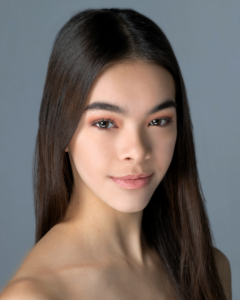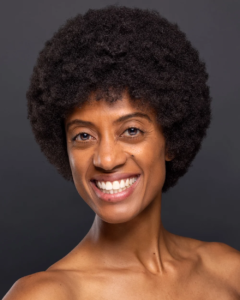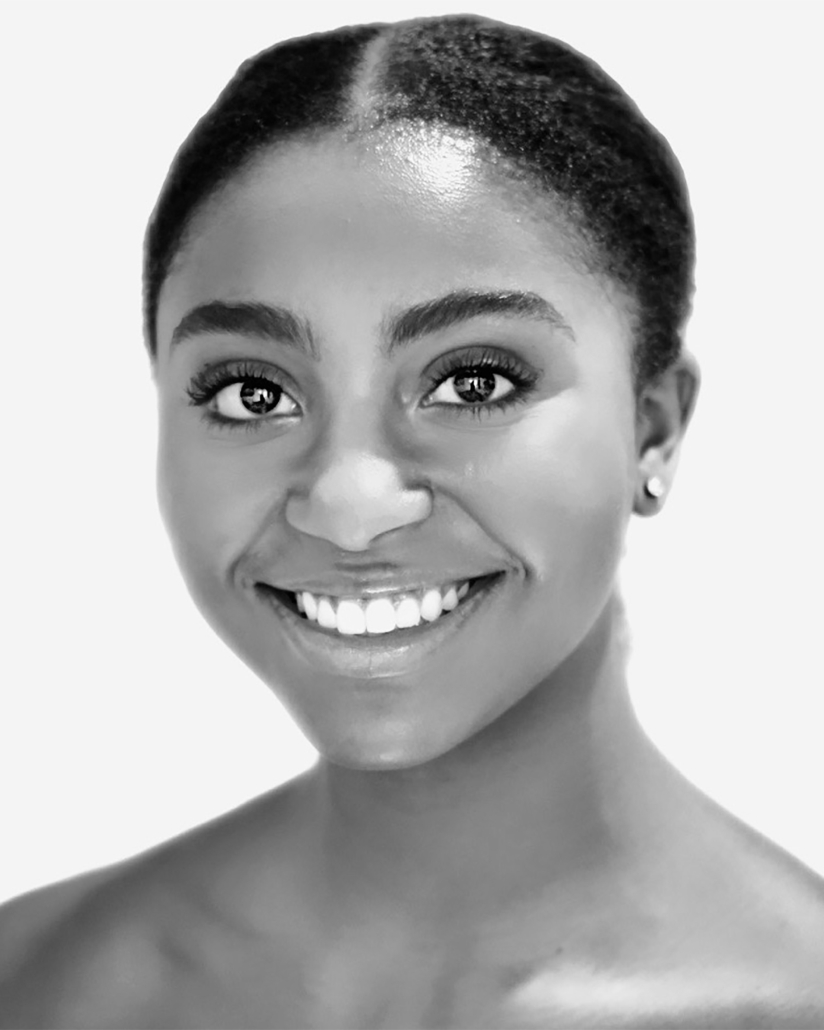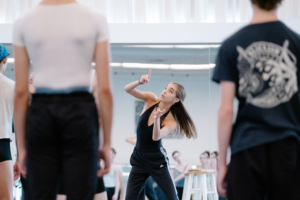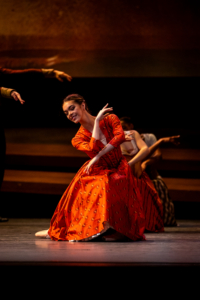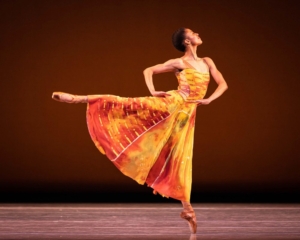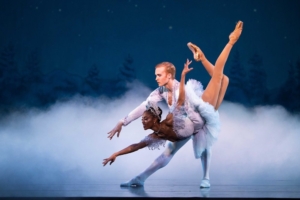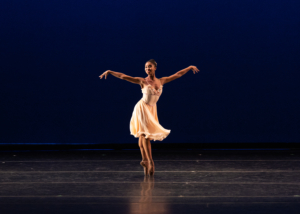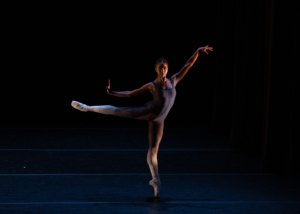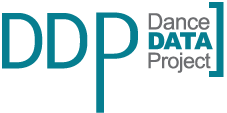DDP Talks To: 3 Choreographers of Color Share Their Stories: From Dancer to Creator
Pemberley Ann Olson from San Francisco Ballet
Katlyn Addison from Ballet West
Maddie Brown from American Ballet Theatre
DDP: What barriers are there for female choreographers in this day and age?
Olson: “I look to the many women before me — dancers and choreographers — who paved the way for the opportunities I have today. They have toughed out the fights of gaining respect and earning the chances that we deserve as female creatives. As a choreographer, I’ve had to create my own opportunities through hard work, consistency, time commitment, flexibility, and perseverance with dancing full time and choreographing simultaneously. Demonstrating pure strength, as women in the corps onstage and as choreographers in front of the studio, continues to drive me to do more.”
DDP: Any advice to schools/universities to support the advancement of female choreographers?
Olson: “In my experience, joining in on free choreographic workshops and master classes as a young student helped me realize I really loved choreographing at a young age. The more chances given to young dancers to see what it’s like to create, the more talent we gain into our dance and choreography world. Inspiration sparks more inspiration.”
DDP: How did creating commissioned work help elevate your career?
Olson: “With every work I’ve created, the better I’ve gotten. I always love to say, “You learn more by doing.” After choreographing for a couple of years, I am more knowledgeable with counts, learning steps quickly, spacing, musicality, artistry, and basically have a better ballet IQ.”
DDP: What was your obligation to the company as you created this work?
Olson: My obligation to my company, and my number one priority, is to always be able to balance being a full-time corps member and a choreographer, doing my work with 100% commitment.
DDP: How did the opportunity to be a part of the Creation House Choreographic Fellowship come about? (Through a connection, a mutual party, an application, etc.)
Olson: “Tamara has been known for giving new career opportunities to members of SF Ballet. Our Director of Artist Development Kerry Nicholls had co-created Creation House as a chance for anyone in the company to apply to create a piece on the SF Ballet School students with artistic freedom and, even better, with coaching and personal feedback from choreographic pros. I was very eager to put in an application and I’m so thrilled I did.”
DDP: How can the process and art of commissioning work be improved upon?
Olson: “Having been through the choreographic and creation process a couple of times myself, what institutions can do to help young or early-career choreographers is provide support in clearing music rights, getting costuming, staging, lighting, and so forth. Basically, putting together all the small details that budding choreographers may not think about until later on, but sometimes make all the difference. These are the nuts and bolts of choreographic work, and any help in making this process more seamless would be a huge improvement to the experience.”
Quote from Artistic Director Tamara Rojo:
“As an Artistic Director, I feel a responsibility to provide resources and opportunities for emerging choreographers of all levels of experience—both from within our own company and beyond. I am grateful that through these offerings, new voices within our dance community have been able to explore their choreographic process and create new works that reflect a variety of perspectives, furthering our art form and expanding the audiences that might resonate with the work we present.”
DDP: What experience have you had so far as a choreographer?
Addison: “I have been a choreographer for the past five years. My experiences include creating three works with Ballet West, excluding my newest piece, Andromeda, which will premiere on May 14. Additionally, I have choreographed one work each for the University of Utah, University of Oklahoma, Kansas City Ballet, Ballet Jorgen in Canada, Bayou City Ballet, Ballet Des Moines, the Arts Festival in Utah, Redlining Project, and the Gateway Chamber Orchestra.”
DDP: Which choreographers have you considered as formative influences or models for your artistic development? Please add some brief words about your influences.
Addison: “Many choreographers have influenced my work. Donald Bryld, with whom I worked at the Kennedy Center, taught me that creativity doesn’t always require extensive new material. His approach of reworking and reimagining existing choreography highlights the inherent potential within even a small amount of movement. This too is very similar to my work with Robert Binet. The principle of finding innovation through manipulating the existing movement, I have created, resonates in certain moments of Andromeda, where familiar ballet vocabulary is presented with a fresh perspective. Furthermore, my experiences performing the works of William Forsythe, Jiří Kylián, Christopher Wheeldon, Frederick Ashton, George Arpino, Helen Pickett, Ben Stevenson, Val Caniparoli, and many other choreographers have consistently reminded me that a compelling story can be told within the simplicity of movement, especially when combined with a strong narrative.”
DDP: What is this piece’s impetus (and title), and what do you hope audiences will take away from the work you have created?
Addison: “The title of my new work is Andromeda. The impetus for this piece came from a desire to explore a powerful female figure within classical mythology. Andromeda’s strength and willingness to sacrifice herself for her people resonated deeply with me. I hope the audience finds the ballet entertaining and, more importantly, connects with Andromeda’s inner fortitude and selfless act. I aim to convey the enduring power of love, the necessity of courage in the face of danger, and the unwavering nature of faith, even in the darkest of times. Ultimately, I hope the audience falls in love with Andromeda’s story and leaves the theater eager to experience a full-length ballet of her journey in the future.”
DDP: Briefly describe this work regarding the sections and the language/vocabulary that movement dancers will perform.
Addison: “The movement vocabulary in Andromeda is rooted in classical ballet, but with moments of more contemporary fluidity. This new work a narrative ballet telling the story of Andromeda through the lens of Andromeda. The ballet is broken down into eight scenes: I – The Constellation On, II – Aethiopia, III – Cepheus and Cassiopeia, IV – A Resolution And A Sacrifice, V – Ribbons And Robes, IV – In Winged Shoes, VII – Cetus and Perseus, VIII – Andromeda and Perseus.”
“Here is my playbill synopsis: ANDROMEDA is a dramatic and unique take on the Greek myth of royal pride, divine wrath, and enduring love. Aethiopia celebrates the birth of Princess Andromeda. Years later, Andromeda’s beauty and kindness have become legendary. Queen Cassiopeia boasts that Andromeda surpasses the gods in beauty. This incurs the wrath of Poseidon, who demands the princess as a sacrifice or he will destroy the kingdom and all its people. In the throne room, as the King and Queen despair and the city pleads, Andromeda bravely offers to save her people and agrees to be sacrificed to the monstrous Cetus. The Greek hero, Perseus, discovers Andromeda, who is tied to the rocks and awaiting her fate. He instantly falls in love with her. Learning that Poseidon has demanded Andromeda’s sacrifice to Cetus, Perseus confronts and defeats the sea monster using Medusa’s head to turn it to stone. Freed, Andromeda finds love with Perseus amidst the danger they have overcome.”
DDP: What music will you be using? If available, please provide any information about costumes or props.
Addison: “The score is an eight-movement work composed by Jonathan Sanford and pre-recorded in Los Angeles. It utilizes traditional orchestral instrumentation and features a small group of vocalists, an organ, and a bit of a violin concerto for the sixth and seventh movements. The violin soloist represents Perseus, while the vocalists, at different times, represent the voices of Cassiopeia, Andromeda, Poseidon, Nereids and the people of Aethiopia. Jason Hadley and Cindy Farrimond from Ballet West Costume Shop are reusing costumes from previous ballets at Ballet West and redesigning and adapting them for my new creation. The Ballet West production team will design props. James Larsen will be designing the lighting.”
DDP: What from your Ballet West experiences has helped you prepare for Works from Within?
Addison: “Dancing in such a wide range of ballets at Ballet West has prepared me for Works from Within. For instance, my experience performing in a Balanchine work honed my understanding of musicality and precision, influencing the intricate phrasing in the pas de deux between Andromeda and Perseus. Similarly, the dramatic storytelling inherent in some of the narrative ballets I’ve performed has informed my approach to conveying the emotional arc of Andromeda’s sacrifice. As this is my first time creating such a work, my deepest hope is that the character of Andromeda resonates and connects with each audience member.”
DDP: Do you foresee working extensively as a choreographer in your future career?
Addison: “I hope to become a resident choreographer somewhere or consistently create works for various companies. The process of bringing a story to life through movement and collaborating with dancers and other artists is incredibly rewarding, and I am particularly drawn to exploring narratives that highlight human resilience and connection.”
Quote from Artistic Director Adam Sklute:
“The art of choreography is the one art that cannot be fully accomplished alone. I built Works from Within to give our artists access to dancers, time, space, and all manner of production elements.”
DDP: You say Crimson Flame, your recent work for ABT Studio Company, “embodies the energy, unpredictability, and transformative nature of fire, evoking both its destructive force and its capacity to illuminate.” What inspired this work?
Brown: “I was inspired by the flame of a fire. Fire always adapts to its surroundings to strive to stay lit, searching for oxygen to grow. Much like my personal journey as both a dancer and a human I feel much like a flame. Dance ignites the fire and passion in me. Heavy winds may try to extinguish my fire, but those same winds can also fuel the flame., causing it to grow stronger. When I picked the music for this piece I felt that the music embodied my vision of the soft flickering of the start of a flame and how it is boldly born into a strong light as winds feed the body of the flame to its height. A fire can always burn brighter and has the capacity to grow uncontrollably. It is both delicate and dangerous and needs to be harnessed to properly reveal the beauty in the flame. Similarly, in my choreography, as the movements speed up it portrays the uncontrollable and unpredictable nature that fire holds and the beauty that it can portray.”
DDP: You choreographed Crimson Flame on the ABT Studio Company–of which you were once a part. Did that give you new insight on being a student in the room with choreographers for ABT?
Brown: “Returning to the studio company as a choreographer I took note of the creation process of past choreographers I have worked with. The work I did with the studio company helped expose me to varied creative processes of choreography . It made me aware of how I wanted to plan my own piece, so I didn’t go in blind. As a dancer that works with different choreographers, I drew upon my past experiences to prioritize my time and set the pieces on the dancers.”
DDP: You shifted from dancer to choreographer to dancer again during your most recent season with ABT. Can you speak to this adjustment? What advice would you give to other dancers starting this journey?
Brown: “In my opinion there wasn’t a shift. Even when choreographing I still used my knowledge as a dancer. It was more finding a balance between continuing my fresh career as a dancer and exploring the new creative process in choreography. Something I wish I would have realized sooner is that as someone who is starting to create, learning and trusting what your body wants to do first is usually how your creative intuition as a choreographer is coming to surface – don’t question it even if it’s something that’s new but also uncomfortable. In moments where I encountered personal barriers, I pushed the limits to allow creativity to override my inhibitions.”
DDP: In 2023, you became an apprentice and in 2024, joined the corps de ballet at ABT. How did you adapt to these new roles? What was the hardest part of stepping into more responsibility?
Brown: “When I first became an apprentice, it was surreal. It was more of a gradual shift. Going through the apprentice program helped me get more insight and prepare for what it would be like for the main company. I would say the hardest part is handling injuries and knowing when to push your body and when to stop. There is no longer someone in the room that is guiding you to make calls on how far you can push your body and its limits. As a professional dancer I am now the one responsible for making sure that my body is at its best. Sometimes this means doing less in the present to do more in the future… to give my body the time it needs to rest and recover for what’s to come. Ultimately, the hardest part is the quest to perfect and unperfectable art.”
DDP: Did you have any mentors as you progressed from being in ABT Studio Company, to an apprentice, to a dancer in the corps de ballet? How did they influence your path and growth?
Brown: “I would have to say one of the most monumental mentors in the start of my career with ABT Studio company would be Sascha Radetsky. He brought me on to the studio company very young, at sixteen, and saw the potential in me that I could become the artist I aspire to be. With his trust and encouragement, he gave me the opportunity to step into difficult choreography for the first time. He was and continues to be a trusted source on my journey.”
DDP: In an interview with Equinox, you shared that “Misty Copeland broke the ultimate glass ceiling at ABT and I hope to continue to build on the great legacy she has created.” What do you dream of leaving behind as your legacy within the dance industry?
Brown: “I would like my legacy to inspire young women and dancers…to instill in them that the same confidence you had from the very first time you started dancing should always remain true and a part of you. There is no limit to what you can achieve when you are passionate and willing to put in the work. In the end, you’ve got to dance like no one’s watching while also appreciating the audience for being there.”
Quote from Artistic Director Susan Jaffe:
“In my quest to bring diverse choreographic voices to the programming of ABT, I make sure there are opportunities on an annual basis for women and artists of color–whether new or already created works–to have a place in our programming. This creates a rich array of voices that adds to the creativity and innovation of ABT.”


